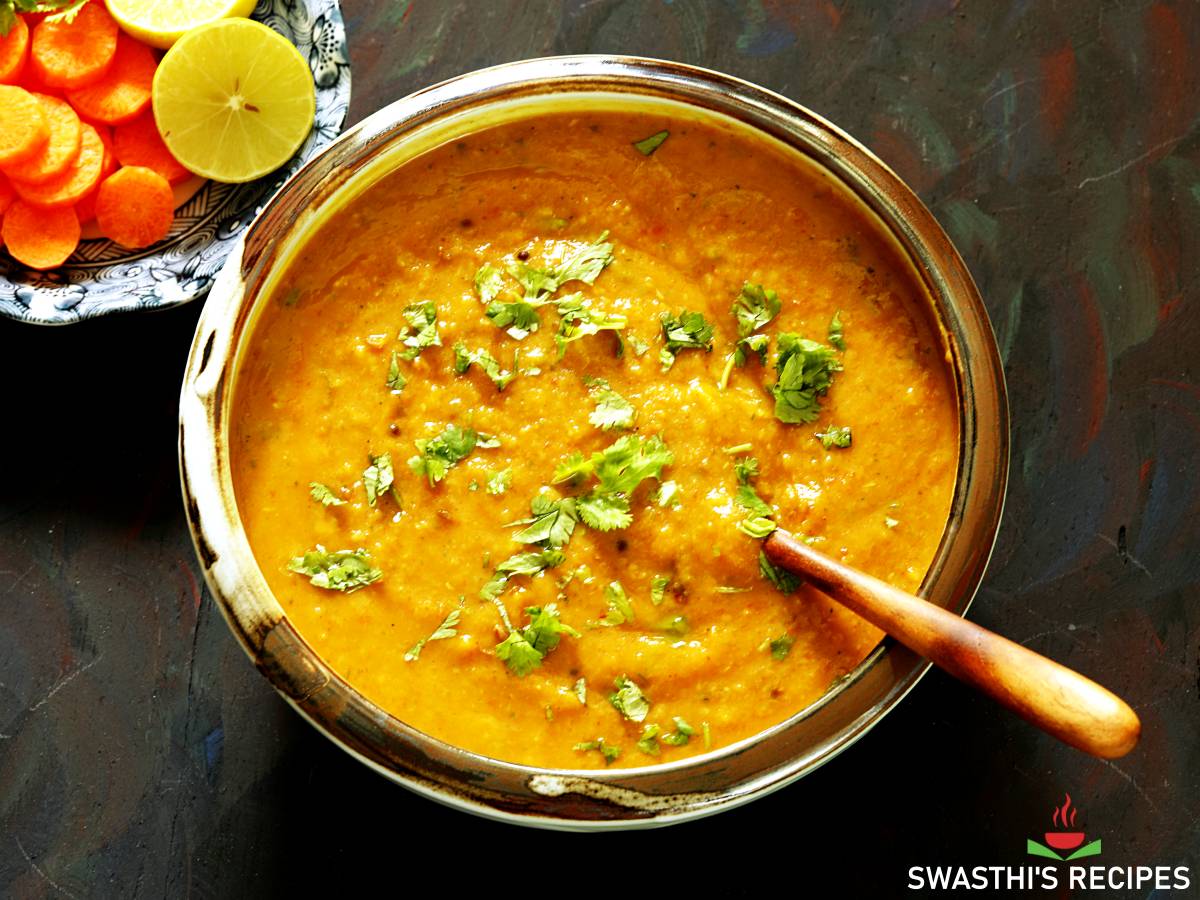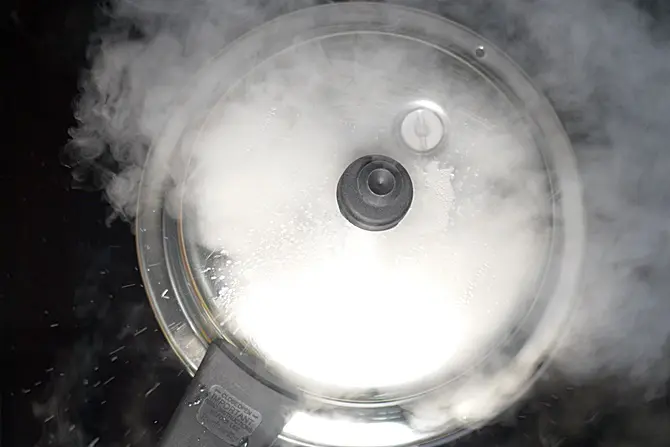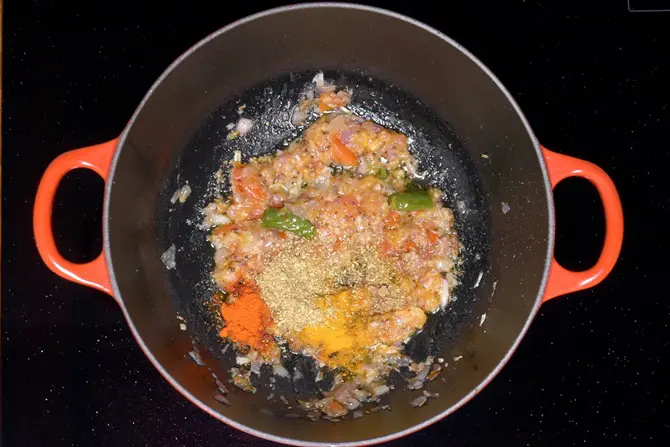Dal Fry is a delicious and popular Indian dish made with lentils (toor dal), onions, tomatoes, spices and herbs. Dal refers to lentils and are a staple in most Indian homes. There are numerous ways a dal recipe is made. Dal fry is a quintessential side dish, be it in Indian restaurants or in homes. Apart from being nutritious, it is a comfort food & is super easy to make. Serve this delicious dal fry over Basmati rice, quinoa or with naan, roti, Chapati or any flatbreads of your choice.

If this is your first try, you will wonder how a handful of pantry staples can really whip up to a delicious, aromatic and healthy protein-packed meal. This dal fry can be made in a regular pot on your stove-top, or in a stove top pressure cooker or an Instant pot. I have included the detailed instructions for all the 3 methods below.
What is Dal Fry
Dal fry is a popular Indian lentil dish where soft cooked toor dal (Skinned Split pigeon peas) aka lentils are simmered with a fried tempering consisting of ghee, whole and ground spices, onions, tomatoes and herbs. There is actually no deep frying involved in the process of making dal fry, but the tempering is fried in 1 to 2 tablespoons ghee or oil to bring out the aroma of various aromatic ingredients.
Though the dish can be made with any lentils of your choice like moong dal, chana dal or masoor dal, Toor dal (split pigeon peas) are most widely used. In restaurants a combination of toor dal and masoor dal is used.
Every family has their own choice and preference of lentils, spices and herbs used in a dal fry recipe. So you may find recipes made with different kinds of lentils, spices levels, herbs etc. But what remains same, is the method of making dal fry.
Dal fry is made by soft cooking toor dal (split pigeon peas) in a pressure cooker or pot. Then whole spices, ginger, garlic, onions, tomatoes and spice powders are sautéed/fried in ghee and then dal is simmered in it. Hence it is known as DAL FRY.
Since fry is a common term used to mention saute in Indian terminology, the dish is called so. But actually there is no deep frying involved while making it.
About This Dal Fry Recipe
This recipe will give you one of the best dal fry. It is mildly spiced yet full of flavours with a perfect texture that can please your whole family. As I mentioned earlier, dal fry is usually made with toor dal but feel free to use any lentils of your choice.
I always prefer to use little amount of moong dal along with toor dal as it enhances the texture and flavor of the dish.
There are few different kinds of toor dal available in the market & the flavour profile is different. Even in India we get different kinds of toor dal. Some impart a slightly sweeter aroma giving a smooth texture while others don’t.
So if you do not know whether the toor dal you are using is going to give you the best dal fry or not, simply add a small quantity of moong dal or masoor dal. This not only enhances the aroma & flavour but also the texture. Moong dal also avoids water being separated from cooked toor dal.
For the very same reasons, dhabas and restaurants add some amount of masoor dal (red lentils) to dal fry and dal tadka.

To make the best dal fry, the quantity and the combination of spices used is the key. Avoid using too much spices, especially chilli powder as it totally alters the flavor of dal. Instead for extra heat use green chilies.
Dal fry is eaten with plain regular rice or with roti. On occasions we also eat it with Jeera rice, ghee rice or with Indian flatbreads like plain paratha, methi paratha, palak paratha & even with butter naan.
We also love papad, pickle, simple vegetable stir fry or a vegetable salad on the side with dal fry and rice.
How to Make Dal Fry (Stepwise Photos)
Cook Lentils
1. Add 1 cup dal to a pressure cooker or pot and wash several times till the water runs clear. Pour 2½ cups water. If cooking in a pot you will need to add more water. I have used only toor dal this time, but I usually use ¾ cup toor dal and ¼ cup moong dal. Using moong dal not only adds taste but the texture is also great.

2. Pressure cook for 2 whistles on a medium heat. If cooking in a pot, cook until the dal turns mushy and soft. When the pressure comes down, open the lid mash the dal well.

Make the Dal Fry Masala
3. Heat 1½ tablespoons ghee in a pan. When it becomes hot, add the following:
- ½ teaspoon mustard seeds (optional)
- ½ to ¾ teaspoon cumin seeds
- 1 broken dried red chili (optional)
- When the spices begin to splutter, add ⅛ teaspoon hing (optional)
- 1 sprig curry leaves (optional)

4. Add ¼ cup finely chopped onions (1 medium) and 1 to 2 chopped green chilies. Saute until onions turn golden.

5. Add 1 teaspoon ginger garlic paste (or ½ inch ginger and 2 garlic cloves fine chopped). Saute until the raw smell of the ginger and garlic goes away. This takes about a minute.

6. Add ½ cup chopped tomatoes (1 large) and ¾ teaspoon salt. Saute until the tomatoes turn mushy and soft.

7. Then add the following spice powders:
- ¼ teaspoon turmeric
- ½ teaspoon red chili powder (adjust to taste)
- ¼ to ½ teaspoon garam masala (adjust to taste)

8. Saute until this mixture smells good. It takes a minute or two.

9. Add cooked & mashed dal.

Simmer Dal Fry
10. Stir well and let cook. If needed you can add more water to suit your liking. When it cools down it will thicken a bit. We prefer dal fry to be thicker in consistency.

11. When the toor dal begins to bubble well, take ½ teaspoon kasuri methi in your palms and crush them well. Add it here. Taste test and add more salt at this stage.

12. Add coriander leaves and switch off. Mix well

13. Turn off the stove. Add lemon juice as desired just before serving. This is optional.

Serve dal fry with rice, papad, pickle or roti.

For more dal recipes, you can check
Dal makhani
Dal palak
Chana dal
Rajma recipe
How to cook Dal in a pot without cooker
Rinse 1 cup lentils under running water. Add them to a heavy bottom pot or dutch oven. If you want you can also soak them for 30 minutes in warm water, to cut down the cook time. Discard the water after soaking.
Pour 3 cups water and bring the water to a boil on a high flame. Turn down the heat.
Cook them uncovered until soft adding more hot water as needed. If you see a lot of froth while cooking the dal, you can skim it off.
We need soft and mushy lentils to make dal fry. When you see the lentils are done. Turn off the heat and keep covered.
In a small pan, make the masala following the recipe. Add that to the pot of lentils you cooked.
Instant pot Dal Fry
1. Press the SAUTE button on the instant pot and pour ghee to the steel insert. When the ghee melts, add the cumin seeds, dried red chilli & mustard seeds (optional). As soon as the spices crackle, add curry leaves, ginger garlic & hing.

2. Add onions and green chilies. Saute for for 2 to 3 mins. I have skipped onions here.
3. Then add tomatoes and salt. Saute until tomatoes break down and become mushy. Add turmeric, red chilli powder and garam masala.

4. Give a good mix.

5. Add rinsed dal and press cancel. Pour 3 cups water.

6. Deglaze the pot with a wooden spatula by scrubbing the bottom of the pot to release any particles of food stuck. This will prevent the burn.

7. You can also cook rice together if you prefer. Place a long legged trivet and place the bowl of basmati rice (or jasmine rice) on the trivet. Cover the instant pot with the lid and position the steam release valve to sealing.
8. Pressure cook on high pressure and set the timer to 8 minutes. If you are using normal rice, then you can also cook for 10 minutes. When the IP is done, wait for natural pressure release. Or at least for 10 minutes and release the rest manually.

9. Using a spatula mash the dal to your liking and add kasuri methi. Dal fry will be thick at this stage, pour ¼ to ½ cup hot water to bring it to right consistency.

Garnish with coriander leaves. When the temperature comes down, sprinkle some lemon juice. Serve dal fry with rice or roti.

Ingredients & Substitutes
Choice of Dal or lentils: The main ingredient used to make dal fry is the toor dal or arhar dal which is known as split pigeon peas in English. It can be made using any dal of your choice like moong dal, masoor dal, chana dal or even with mixed lentils. My preferred choice is a combination of arhar dal and moong dal.
Ghee or oil: Dal is always tempered with ghee as it totally elevates the flavor and taste. If you are a vegan then you can just use oil. If you do not have ghee, use 1 ½ tablespoons unsalted butter with ½ tablespoon of oil. Mustard oil also gives a very good flavour if you want to use oil.
Onions impart sweet tones to the dish. If you do not eat them, just skip using them. Dal fry still tastes good without onions and I use skip them a lot of times.
Tomatoes are very essential in this recipe. Without them your dal fry won’t have the flavour and tang that comes from the tomatoes. Fresh ripe tomatoes are best for this recipe. Avoid using raw or unripe tomatoes.
Spices
Whole spices: We don’t need a lot of whole spices to make this dal fry. Mustard and cumin seeds (jeera) are the main spice used in the tempering. However if you do not then skip the mustard seeds, but you will miss the pungent flavour.
Dal fry is made across India some regions don’t use mustard seeds at all.
Ginger and garlic: Fresh chopped, crushed or grated ginger and garlic can be used. There is no substitute for both these but use at least one of them if not both.
Spice powders: Using a lot of spice powders like turmeric, garam masala, red chilli powder and coriander powder will just alter the original flavor of dal. So use only a fair amount of them.
Chilies: I have used only green chilies for heat. You can use both dried red chilies and fresh green chilies. 1 to 2 dried red chilies impart heat and a pungent flavour to the dish. You don’t need really hot green chilies here. I use the Indian or Thai green chilies that are not very hot.
Kasuri methi is one superb herb that has no substitutes & fenugreek seeds won’t work here. These are dried fenugreek leaves which impart a great unique aroma. It is easily available in the Indian grocery stores or on amazon.
The ingredients that are used in a dal fry recipe vary depending on the region and personal choice. You can also check this moong dal recipe for variation.
Pro Tips
Soaking lentils cuts down the cooking time. Aged or old lentils take longer time to cook and need more water. So use lentils that are fresher in stock.
Avoid using lot of spices as it kills the original flavour of dal.
A well-made dal fry has a dominant flavor and taste of lentils with a delicate aroma of ghee, spices and herbs. If you like your dal hot, use hot green chilies and avoid adding a lot of red chilli powder.
Adjust the consistency of the dal by adjusting the amount of water as needed. Dal fry is not of runny consistency yet not too thick. It must be thick and yet of pouring consistency. It will thicken further after cooling.
Faqs
Yes arhar dal and toor dal are same.
Good quality toor dal is unpolished & won’t have a shiny oil coating over it. For extra shelf life normal toor dal is coated with oil which looks really good even after staying in the shelf for very long. The best way is to buy organic dal from a trusted brand and store.
Dhal is an Indian dish made with lentils, spices, tomatoes and herbs. It can be made with any kind of lentils like yellow lentils, red lentils, black lentils and many more.
Toor dal is known as split pigeon peas in English.
Yes arhar dal is good for health as it is rich in protein, carbohydrates, fiber and many essential nutrients. It is good for the over-all well being.
Soaking helps the toor dal to cook faster. If you are cooking in a pot or dutch oven, soak them for 30 to 60 minutes. To cook in pressure cooker or instant pot, you don’t need to soak as it cooks very well under pressure.
Dal when perfectly cooked becomes mushy and won’t hold shape. Mash a few lentils in between your thumb and forefinger to know if they are really well done and mushy.
Dal fry is when you add cooked dal to the sautéed/ fried masala & simmered for a short time. Dal tadka is when you pour tadka (tempering) over cooked spiced dal & no further cooking is done.
More on dal fry vs dal tadka
The sautéed/ fried masala for dal fry is made with mustard, cumin, ginger garlic, red chili powder, hing, onions & tomatoes. Sometimes also curry leaves, red chilies, kasuri methi and garam masala are used.
The tadka for dal tadka is made with ghee, cumin, garlic, hing, red chilies and chili powder. Sometimes even coriander leaves are used.
There is no one right way to make these dishes. So a lot of people also add tadka to just dal fry to transform it to dal tadka. But the tadka is all that makes a huge difference here.
Related Recipes
Recipe Card
- Cooking dal in pot: Rinse and soak 1 cup lentils in warm water for 30 to 60 minutes. This helps to cut down the cook time. Drain the water and pour 3 cups fresh water and bring it to a rolling boil. Simmer and cook uncovered until soft and mushy adding more hot water as required. If you see a lot of froth, skim it off. Dal must be soft before adding it to the masala.
- For a gluten-free option, skip asafoetida in the recipe or use a gluten-free asafoetida.
- For a vegan dal fry, substitute ghee with any vegetable oil of your choice.
- Dal fry can be made with any lentils of your choice like moong dal, chana dal or masoor dal. You can use toor dal alone. Use a mix of toor and moong dal for the best texture, aroma and flavour.
- Soaking lentils cuts down the cooking time. Aged or old lentils take longer time to cook and need more water. So use lentils that are fresher in stock.
- Avoid using too much of ground spices like garam masala, red chilli powder or turmeric as this alters the original flavour of lentils. If you prefer spicy dal fry, use hot green chilies instead.
- To make it a complete balanced dish, you can also add veggies like carrots, bell peppers and spinach. You can add them along with the tomatoes or after the tomatoes are softened. Ensure the bell peppers and spinach isn’t over cooked.
Alternative quantities provided in the recipe card are for 1x only, original recipe.
For best results follow my detailed step-by-step photo instructions and tips above the recipe card.
Watch Dal Fry Video
Nutrition Facts
Dal Fry Recipe (Restaurant Style Dal Recipe)
Amount Per Serving
Calories 355
Calories from Fat 99
% Daily Value*
Fat 11g17%
Saturated Fat 6g38%
Cholesterol 26mg9%
Sodium 659mg29%
Potassium 892mg25%
Carbohydrates 47g16%
Fiber 22g92%
Sugar 5g6%
Protein 18g36%
Vitamin A 674IU13%
Vitamin C 25mg30%
Calcium 81mg8%
Iron 6mg33%
* Percent Daily Values are based on a 2000 calorie diet.
This recipe was first published in March 2017. Updated and Republished in June 2022.
About Swasthi
I’m Swasthi Shreekanth, the recipe developer, food photographer & food writer behind Swasthi’s Recipes. My aim is to help you cook great Indian food with my time-tested recipes. After 2 decades of experience in practical Indian cooking I started this blog to help people cook better & more often at home. Whether you are a novice or an experienced cook I am sure Swasthi’s Recipes will assist you to enhance your cooking skills. More about me
Follow Swasthi’s Recipes






GIPHY App Key not set. Please check settings